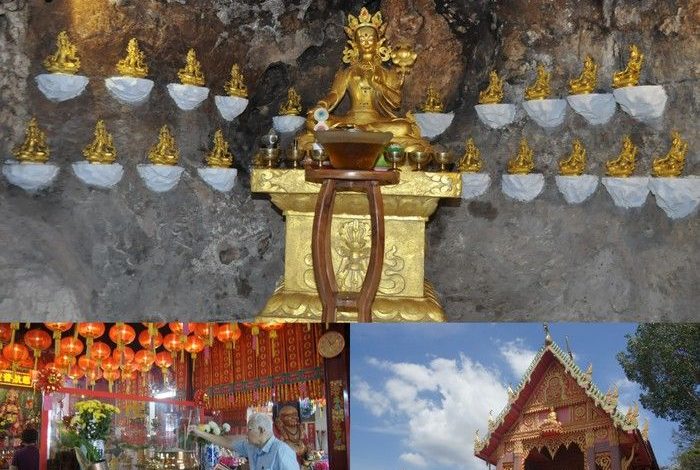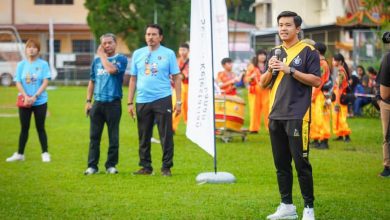

By Tan Mei Kuan, Ili Aqilah Yus Amirul and Khaleeja Suhaimi
From Buddhism to Taoism, there are many lesser known temples in Ipoh, outside of most tourist itineraries. They may be relatively smaller in size but their rich history and distinctive style are no less spectacular than other iconic temples. Plus, it provides a more relaxed visit than the more popular temples in Ipoh. Let the off-the-beaten-track journey begin!
Far from the Madding Crowd: Ipoh’s Lesser Known Temples
Long Tow Ngan Temple
Taoist priest, Lee Sooi Fong, is generous and amiable to every visitor of the Long Tow Ngan (Dragon Head Cave) Temple. Located in the north of Ipoh, the Taoist temple was founded in 1854, making it one of the oldest temples in Perak. Dignitaries who have supported the temple include the late Lam Look Ing, the late Dato’ Lau Pak Khuan and Tun Dr Ling Liong Sik.
The name of the temple is derived from its geographical structure. Located at the end of the long Gunung Lang mountain range, the temple site resembles a dragon head chasing a pearl while facing north, the pearl being the solitary limestone outcrop located adjacent to the range. Just imagine how scenic it is!
The limestone cave in which the temple resides in Gunung Lang, opens up into a giant space where the main prayer hall is located, under a canopy of red lanterns with golden tassels. It then branches off into hidden recesses. Following the principles of feng shui, the picturesque temple harmonises perfectly with the surrounding environment, hence it is brimming with wonders of nature such as centuries-old mature trees and natural rock formations resembling animals, humans and even deities.




“The space accommodating the main prayer hall opens up naturally, it has not been excavated and artificially created. The temple began with just this space. Visitors usually come for the scenic view, to pray for wellbeing and to be enlightened. With Guan Di Ye (God of War) and Tai Shang Lao Jun (God of Longevity) as the presiding deities, believers also pray to, among others, Great Emperor of Jade, Three Pure Ones, Tai Sui Yeh (Grand Duke Jupiter), Man Cheong Dai Di (God of Literature) and Tai Pak Koong (God of blessing and ethics),” Lee explained to Ipoh Echo. He is the fifth generation priest here, having taken over from his father in 1999.
“The four major events here are the Tai Shang Lao Jun Festival during February 15, Man Cheong Festival on the third day of Chinese New Year, Kuan Yin Festival on February 19 and Kong Zi Festival on August 27. We have prayers during these days. For Chinese New Year Eve, we have lighting of the first incense of the year, welcoming the God of Prosperity and lighting of the 9-lamps for wellbeing. During the busiest day, we have received over 40 tour buses. Visitors love to visit during the Chinese New Year, public holidays and weekends,” Lee said.


“Over 20 natural rock formations appear in pairs, like the yin and yang in Taoism. For instance, one resembling a fist signifying stinginess and another resembling an open palm signifying extravagance. One must learn to achieve a balance between the two. Equally interesting is one resembling a tiger. Standing from one perspective, it looks like it is fast asleep but from another angle, the animal looks alert,” Lee added.
The temple is currently in need of funds for the refurbishment of the existing building and the completion of a new 5-storey complex to be named Palace of Great Emperor of Jade. Readers who would like to donate can channel the funds to Affin Bank, 1011 1000 5917 (Loong Thow Ngam Temple). The temple welcomes volunteers too.
Address: Jalan Kuala Kangsar, Long Tow Ngan Temple, 30010 Ipoh, Perak. Contact: 012 375 1111 (Lee Sooi Fong) Opening hours: 8am to 5pm daily.Thrangu Dharma Retreat Centre
The history of the cave temple dates back to the mid nineteenth century. In 1895, the temple was exempted from registration by order of the British Resident. Previously a Taoist temple under the name of “Persatuan Penganut Nan Yang Koo Miau”, it has been converted into a Buddhist centre in May 2005 which follows the Vajrayana tradition of Buddhism. In January 2008, the Registry of Societies Malaysia approved the new name of the temple as “Thrangu Dharma Retreat Centre”.
The temple has remained unchanged for many years in terms of its facade and cave layout. Situated close to the lively Tambun town, it is nestled amidst lush greenery, exuding the charm and serenity of a retreat. The oasis of peace conducts retreats and prayers under the guidance of its 40-year-old resident Lama, Lama Sangye from Nepal who entered the monkhood at the age of 15.
Among the latest additions to the presiding statues of the centre are the Green Tara (surrounded by 21 Tara), Mahakala (Protector) and The Three Buddhas (4-Arms Chenrezig, Sakyamuni and Guru Rinpoche). The 11-feet Maitreya Buddha (the Buddha of the Future) statue, the first in Malaysia, was built in 2014.




In the cave, elaborate altars in the alcoves are illuminated with gentle golden lights and flickering candles, providing a soothing tranquillity for the holy place. In addition, the natural limestone formations and aroma of incense lends the cave a special atmosphere. The centre is planning to build a residence for the monks and a canteen on the site. Readers who would like to donate towards the maintenance and construction can call the centre at the numbers listed below.
The four-storey centre currently conducts a weekly Sunday practice on Medicine Buddha and 4-Arm Chenrezig. The Green Tara Puja is held on the first week of every month. To welcome the Chinese New Year, the centre usually organises a three-day Mahakala Puja and light offering. Meanwhile, retreats are held upon request and necessity. Each retreat can accommodate up to 50 devotees and can last from one to three days. Interested readers may contact the centre for more information on upcoming activities.
Last year, the centre organised a 5-day Fire / Auspicious Tara / Sutra of Golden Rays Puja from Friday, October 28. Conducted by Lama Yonten from Nepal, Lama Lodro Thaye from PJ Centre and other monks, the special event aimed to remove obstacles, improve health and benefit all sentient beings.
Address: 7.5 Miles, Jalan Tambun / Tg Rambutan, Tambun 31400 Ipoh, Perak. Contact: 017 5750755 (Madam Tan Ai Kheng), 012 590 3525 (Mr Tan Peng Seng), 012 420 7379 (Mr Cheong) Opening hours: 9am to 5pm daily (do call prior to arrival).

Temple by the River, Sui Yuet Goong
Built for the use of his family, a former tin miner with the surname of Soo built the Sui Yuet Goong (palace) in 1878. What is unique about this Taoist temple is that it is located near a river. In fact, the direct translation for Sui Yuet is ‘Nearby the water’.
“Back in those days, most of tin miners were immigrants. To get to Tanah Melayu (Malaysia) they had to take boats. As a sign of gratitude for arriving safely, the immigrants decided to built a temple and pray,” said Tang Ngan Chai, the caretaker of the temple, as the reason for its name.
Although it was for private use, more and more devotees would come by and that was when the temple was open to the public. Devotees who come would pray to the Goddess of Mercy, Guan Yin.




“In here, believers pray to Guan Yin for good luck, health and prosperity. They come to the temple and buy the prayer sticks we provide in the temple and everyone is more than welcome to donate to the temple, regardless of what amount,” added Tang.
Open everyday from 7.30am till 4pm, Sui Yuet Goong celebrates the day Goddess of Mercy, Guan Yin became a saint, that falls on the 19th day of the second month in the lunar calendar. During the day, devotees will come and pray to the deity. The temple will also extend their opening hours on these days to give devotees a longer time to pray.
Sui Yuet Goong is located at Jalan Kampong Jawa, 30000 Ipoh (opposite Seri Kinta Building).


Watt Siribunya Maggarama


The temple is more than 120 years old though the founder of it remains a mystery. Lord Buddha’s altar is placed inside the Main Shrine Hall Vihara, with a backdrop of a mural painting. The devotees who go to this temple pray to Lord Buddha.
“We receive the most visitors during Chinese New Year and every first and fifteenth of the month according to the Chinese calendar,” said Teh Cheng Chai, one of the helpers at the temple.
According to beliefs, the first and fifteenth day of the lunar month are said to be auspicious days. Thus, the merits would be multiplied many fold if they were to practise good deeds. That’s why devotees make great offerings and pray for their blessings and prosperity.


Recently, the temple was overwhelmed with people during the passing of Thailand’s King Bhumibol Adulyadej. They all came to pay homage to the King as he was greatly loved by all.
Open every day from 7am till 6pm, everybody is welcome to visit and have a look at the majestic structures of the temple. It is situated at: 89-90, Jalan Raja Dihilir, 30350 Ipoh, Perak.


Paloh Khoo Miu Temple


Born in the Mei Xian district in Guangdong Province of China, Leong Fee came to Ipoh by river from Penang. He brought with him the spirit of the deity with burning joss sticks from a temple in Hai Zhu Island near Penang and founded the temple alongside the Kinta River to give thanks for safe arrival. In 1894, Leong Fee and Yau Tet Shin, another famous miner, entrepreneur and pioneer of Ipoh, successfully applied to the British Colonial Government for a piece of land to build the temple at its present site.
After the Japanese Occupation, Lau Pak Khuan, later to become the first Chinese Dato’ Seri, was elected as the chairman of the board of governors in charge of reviving the temple and laying the foundation of the present temple as it stands today.


Driving through a decorated archway, visitors can park in the designated lots in the temple grounds. One will be greeted by a pair of auspicious stone sentry lions guarding its main entrance. Upon entering, its sunlit main hall is flanked by the eight bronze ceremonial weaponry. Equally impressive are the century-old joss stick holders at the altar.
At the altar of Tai Pak Koong is an intricate wooden carving covered with antique gold leaf, a standing testament of how devotees have put their hearts and souls and hard earned money to honour the deity.
Meanwhile, the yard houses a dragon squirting water from his wishing pond flanked by two carp-filled ponds, adding to the serenity. The ringing of the 124-year-old copper centennial bell and drum each time an offering is made together with the bubbling water create a soothing tone that encourages introspection.
Paloh Khoo Miu Temple receives the most number of visitors during Chinese New Year Eve and the birthday of Tai Pak Koong, which falls on February 16 of the lunar calendar. The latter is an annual grand affair which lasts for days and nights to thank the deity for his blessings.
Address: 89-91, Jalan Bijih Timah, 30000 Ipoh. Contact: +605 255 0407 Opening hours: 7am to 4pm daily.

Ipoh Echo wishes readers near and far a blessed Year of the Rooster! If you know of any other lesser known temples that should be in a travel list, write in to us.


